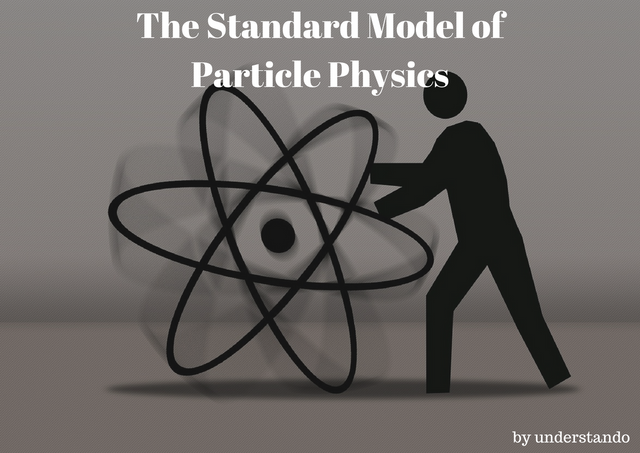The Standard Model of Particle Physics by @understando
The Standard Model of Particle Physics – introduction by @understando

Credits: Illustrations from pixabay with CC0 Creative Commons Licence
Basic principles in the Standard Model of Particle Physics
The primary goal of physics is to explore and uncover the fundamental laws of nature that determine the structure and evolution of our cosmos. These fundamentally formulated principles must be written in a strict mathematical language. [1]
Today groundbreaking experiments give us an even more accurate picture of our world's fundamentals. For example, research at the LHC (discovery of the Higgs) but also in other great research institutions.
The model introduced by Democritus about the innermost structure of matter in the 4th/5th century B.C is of universal validity and impressively simple. He stated that matter is grained. In modern language, this fundamental characteristic of matter is called:
principle of reduction:
The occurring phenomena in nature are traced in the microcosm to a few basics of matter, between which fundamental forces act. [2]
This research object of particle physics, also operationally characterized as high energy physics, explores the material structures and forces in the microcosm.
The resulting picture is amazingly simple, clear and very accurate. Richard Feynman once symbolized the strength of the standard model like this:
"The standard model is working too well".
While the development of the model is by no means complete, we need to be prepared for new and breathtaking insights.
„The developed model clearly points out to a comprehensive understanding of the physical structure of our universe since its creation in the Big Bang more than ten billion years ago. In this area, particle physics of the microcosm interacts with cosmology, the study of the form and evolution of the universe. Particle physics and cosmology are thus the crucial roots of science, and they are among the highest cultural goods created by humanity."

Credit: CC0 Creative Commons / pixabay
In the standard model of particle physics, the reduction principle is followed by the synthesis principle:
The building blocks in the microcosm combine to form complex systems and form qualitatively new structures. In summary, one can say that the whole is more than the sum of its parts. This can be illustrated by the following example: Water molecules consisting of two hydrogen atoms and one oxygen atom arrange themselves as crystalline ice at low temperatures, while forming gaseous water vapor at high temperatures, two aggregate states whose properties can not be more different, both of them consist of the same atoms. An almost infinite variety of material manifestations can be created in our world through diverse composition of the basic building blocks. [3] The formation of complex systems is the foundation of our existence and plays an important role in material physics, chemistry, biology, and medicine.The evolution of human civilization is directly dependent on the understanding of this matter.
Until the 30s of the last century, it was considered a "secure knowledge" in the standard model of particle physics that electrons, protons, and neutrons are indivisible basic building blocks of matter. [4] The development of quantum theory contributed significantly to a more detailed description of the atomic structure. [5] Current knowledge indicates that electrons are indeed elemental, this means structureless. [6]
However, researchers from the Helmholtz Center in Berlin have been able to prove that electrons in certain solids split into so-called quasiparticles, which are then carriers of part properties of the electron. [7] Suddenly particles with only spin and those with only the orbital momentum of the electron seem to move independently and at different speeds. The physicists called the "sub-electrons" spinon and orbiton. [8]
In the current standard model of particle physics, protons and neutrons - experimentally confirmed - consist of basic building blocks, known as "quarks". There are also two more "particle families". The standard model of particle physics is based on 3 basic building blocks: particles, forces and masses. [9]
Sources:
[1]P.M. Zerwas: Die Bausteine der Materie im Mikrokosmos, S.1
[2] Vgl. ebd.
[3] P.M. Zerwas: Die Bausteine der Materie im Mikrokosmos, S.1.
[4] Uni Magdeburg, Das Standard-Modell der Teilchenphysik, Internetquelle, S.1.
[5] Important persons of quantum physics: Max Planck developed at 1900 the Planck's law of radiation. More: Werner Heisenberg, Albert Einstein, Erwin Schrödinger, Louis De Broglie, Max Born, Pascual Jordan.
Siehe: https://de.wikipedia.org/wiki/Quantenphysik#cite_note-Planck1900-1
[6]Uni Magdeburg, Das Standard-Modell der Teilchenphysik, Internetquelle, S.1.
[7] Die Welt: Physiker spalten erstmals das Unspaltbare, Internetquelle, o.S.
[8]Vgl. ebd. ; Wikipedia/Spinon
[9] Uni Magdeburg, Das Standard-Modell der Teilchenphysik, Internetquelle, S.1.
If you like this post please Upvote & Follow me. Until next time!